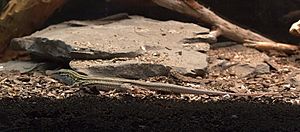Desert grassland whiptail lizard facts for kids
Quick facts for kids Desert Grassland Whiptail |
|
|---|---|
 |
|
| Conservation status | |
| Scientific classification | |
| Genus: |
Aspidoscelis
|
| Species: |
uniparens
|
| Synonyms | |
|
Cnemidophorus uniparens Wright & Lowe, 1965 |
|
The desert grassland whiptail lizard (Aspidoscelis uniparens) is a special type of lizard. What makes it special? Well, all of these lizards are female! They don't need a male partner to have babies. This unique way of reproducing is called parthenogenesis. These lizards used to be known by a different scientific name, Cnemidophorus uniparens. A common animal that hunts the whiptail lizard is the leopard lizard. Leopard lizards catch whiptails by hiding and then pouncing.
Contents
About the Desert Grassland Whiptail Lizard
The desert grassland whiptail lizard is a fairly small reptile. It usually grows to be about 2¾ inches (7 cm) to 5¼ inches (13 cm) long. These lizards are very long and thin. Their tail is even longer than their body!
What They Look Like
You can easily spot a desert grassland whiptail by the six yellowish lines on its body. These lines run from its head all the way to its tail. Most of the lizard's body is an olive green or brown color. This color slowly changes to a light blue or gray on its tail. Young whiptail lizards have a very bright blue tail. Their bodies are covered in small, rough scales. These scales get bigger as they get closer to the tail. The scales on their bellies are much larger and feel very smooth.
Where They Live
The desert grassland whiptail lizard mostly lives in the deserts of the southwestern United States. You can find them in southern and central Arizona. They also live along the Rio Grande river in New Mexico. These lizards are also found in the deserts of northern Mexico.
Their Favorite Spots
A. uniparens lizards often live in low valleys and grassy areas. They also like gentle slopes. Some scientists think that these lizards are spreading to new areas. This might be happening because of too much grazing by animals like cows. You won't find many whiptail lizards in busy towns or places where people keep a lot of farm animals.
How They Reproduce
As we mentioned, all desert grassland whiptail lizards are female. They don't need a male to have babies. This amazing process is called parthenogenesis.
Parthenogenesis Explained
In parthenogenesis, the lizard's body makes copies of its own chromosomes. Chromosomes are like tiny instruction books inside every cell. Usually, animals get half their chromosomes from their mom and half from their dad. But whiptail lizards copy their own chromosomes. Then they pair them up with their own copies. This allows the all-female desert grassland whiptail lizard to have different genes. This variety was once thought to only happen in animals that reproduce with a male and female.
How They Came To Be
These unique lizards came from a mix of two other lizard species. These two species, A. inornata and A. burti, had both male and female lizards. When they bred, they created an all-female lizard. This new lizard then bred with A. inornata. This led to the creation of the uniparens species we see today.
What They Eat
The desert grassland whiptail lizard mostly digs in the ground to find its food. They love to eat termites, queen ants, and beetles. They also eat other small insects they find underground. Sometimes, they also eat prey they find above ground. This includes grasshoppers and butterflies.


